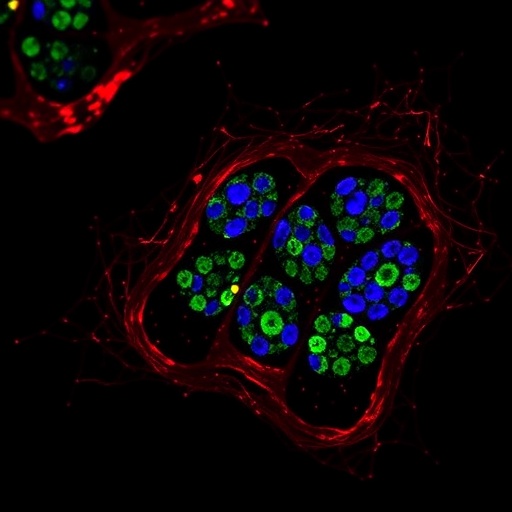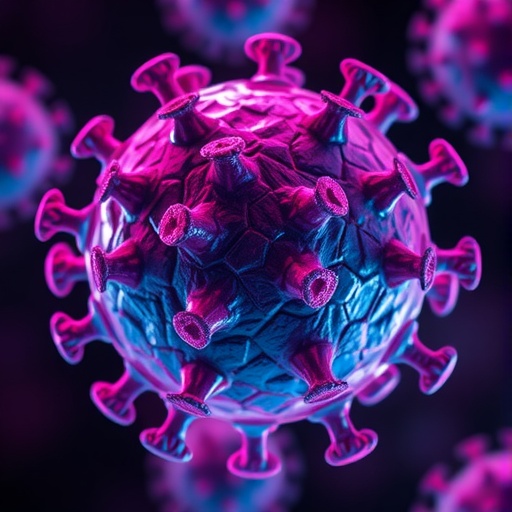
In a groundbreaking correction published in the latest issue of Cell Death Discovery, researchers Wu, Song, Liu, and colleagues shed new light on the intricate role of Islet Amyloid Polypeptide (IAPP) in modulating key cellular processes within human intervertebral disc cells. The study, addressing crucial aspects of autophagy, apoptosis, and extracellular matrix (ECM) metabolism, unveils complex cellular dynamics that could pave the way for innovative therapeutic strategies targeting degenerative disc diseases. This correction not only clarifies previous findings but also deepens our understanding of cellular homeostasis in a context central to spinal health.
Intervertebral disc degeneration is a major cause of chronic back pain and disability worldwide, with limited treatment options beyond symptomatic relief. The intervertebral discs are fibrocartilaginous cushions that facilitate flexibility and load bearing in the spine, and their health is critically maintained by a balance between cellular turnover and ECM integrity. Central to this balance is the proper regulation of autophagy—the process by which cells remove and recycle damaged organelles and proteins—and apoptosis, programmed cell death that removes dysfunctional cells. The study in question delves into how IAPP intricately influences these pathways, offering a nuanced view of disc cell biology.
IAPP, also known as amylin, is a 37-amino acid peptide co-secreted with insulin by pancreatic β-cells. While extensively studied in the context of type 2 diabetes where it contributes to islet amyloidosis and β-cell dysfunction, its role in other tissues such as intervertebral discs has remained enigmatic until now. The novel insights from Wu et al. reveal that IAPP is not merely a pathological bystander but an active modulator of cell fate mechanisms in disc cells. The correction published serves to refine the specific molecular interactions and cellular effects initially posited, strengthening the validity of these observations.
.adsslot_5q0GWyh7DX{width:728px !important;height:90px !important;}
@media(max-width:1199px){ .adsslot_5q0GWyh7DX{width:468px !important;height:60px !important;}
}
@media(max-width:767px){ .adsslot_5q0GWyh7DX{width:320px !important;height:50px !important;}
}
ADVERTISEMENT
Central to the findings is IAPP’s dual regulation of autophagy and apoptosis within human disc cells. Autophagy is crucial for maintaining cellular homeostasis under stress conditions typically encountered by intervertebral discs, such as oxidative stress and mechanical strain. The researchers demonstrate that IAPP modulates autophagic flux, the dynamic process encompassing the formation and degradation of autophagosomes, thereby influencing the survival capacity of disc cells. By fine-tuning autophagy, IAPP helps cells mitigate damage accumulation, potentially delaying the onset of degenerative changes.
Equally compelling is the elucidation of IAPP’s impact on apoptosis. Programmed cell death, while essential for tissue remodeling and removal of irreversibly damaged cells, can exacerbate disc degeneration when dysregulated. The study clarifies that elevated IAPP levels can either promote or inhibit apoptosis depending on the cellular context and signaling milieu, evidencing a complex regulatory role. This bidirectional modulation suggests that therapeutic targeting of IAPP pathways might restore cell populations and maintain disc tissue homeostasis more effectively than previously anticipated.
Moreover, Wu and colleagues emphasize the interconnectedness of autophagy and apoptosis pathways, both influenced by IAPP. Crosstalk between these processes is mediated by a network of signaling cascades including mammalian target of rapamycin (mTOR), AMP-activated protein kinase (AMPK), and Bcl-2 family proteins. By modulating these pathways, IAPP can shift the balance towards cell survival or death, impacting tissue integrity. This interplay has profound implications for understanding how cellular responses orchestrate maintenance or degeneration of the extracellular matrix, a fundamental component ensuring disc mechanical properties.
The extracellular matrix itself, composed primarily of collagen, proteoglycans, and non-collagenous proteins, is dynamically regulated by the resident disc cells. The corrected study highlights IAPP’s influence on ECM metabolism, demonstrating alterations in gene expression related to matrix synthesis and degradation. Notably, IAPP impacts the activity of matrix metalloproteinases (MMPs) and their inhibitors, as well as anabolic factors such as transforming growth factor-beta (TGF-β). This suggests that IAPP is a pivotal regulator in preserving or disrupting ECM homeostasis.
These findings resonate significantly within the realm of spinal research, given that ECM degradation is a hallmark of degenerative disc disease. Disruption of ECM leads to compromised disc structure, loss of hydration, and mechanical dysfunction, culminating in pain and disability. By elucidating IAPP’s regulatory role, the study opens doors to novel biomolecular interventions aimed at restoring ECM balance and halting disease progression at a cellular level.
On a mechanistic level, the correction provides critical clarification regarding IAPP receptor engagement and downstream signaling. IAPP operates through receptor complexes involving the calcitonin receptor and receptor activity-modifying proteins (RAMPs), activating intracellular pathways such as cyclic AMP (cAMP)/protein kinase A (PKA) and mitogen-activated protein kinase (MAPK). Through these pathways, IAPP influences gene transcription programs governing autophagy, apoptosis, and ECM metabolism. The refined understanding of these signaling mechanisms enhances the potential for targeted drug development.
The cell culture models used in the study, derived from human disc tissue, offer clinically relevant insights yet reflect the complexity of in vivo environments where multifactorial influences act simultaneously. The correction underscores the necessity of incorporating physiological conditions such as mechanical loading and inflammatory cytokines in future research to fully appreciate IAPP’s role under pathological states. This approach will accelerate translation from bench to bedside.
From a broader perspective, this research aligns with emerging paradigms linking metabolic dysregulation with musculoskeletal diseases. Given IAPP’s established role in metabolic syndrome and diabetes, its newly characterized involvement in spinal cell biology reinforces the concept of systemic influences on disc health. These interrelations may explain the heightened incidence of degenerative disc disease in patients with metabolic disorders and suggest metabolically oriented interventions might also benefit spinal conditions.
The therapeutic implications are far-reaching. Modulating IAPP activity—either by antagonizing its excessive signaling or enhancing its protective effects—could establish a new class of treatments for intervertebral disc degeneration. Pharmacological agents designed to recalibrate autophagy and apoptosis via IAPP pathways might restore disc cell viability and ECM integrity. Meanwhile, biomarker development for IAPP levels in disc tissues or circulation could improve diagnostic precision and disease monitoring.
This correction, while technical, advances the frontiers of disc biology with impressive granularity, underscoring the importance of peptide hormones in unexpected anatomical sites. It invites further exploration into peptide-mediated intercellular communication and how systemic peptides influence localized tissue aging and pathology. The methodological rigor demonstrated by Wu et al. establishes a benchmark for future studies dissecting complex molecular networks in musculoskeletal research.
In summary, the refined findings on IAPP presented in this correction pivotally deepen our understanding of intervertebral disc cell regulation, offering novel mechanistic insights into autophagy, apoptosis, and ECM metabolism. As degenerative disc disease remains a significant health burden globally, uncovering such molecular modulators holds immense promise. This emerging knowledge sets the stage for innovative therapeutic strategies that might one day alleviate the profound impact of spinal degeneration on millions worldwide.
Subject of Research: The role of Islet Amyloid Polypeptide (IAPP) in modulating cellular autophagy, apoptosis, and extracellular matrix metabolism in human intervertebral disc cells.
Article Title: Correction to: IAPP modulates cellular autophagy, apoptosis, and extracellular matrix metabolism in human intervertebral disc cells.
Article References:
Wu, X., Song, Y., Liu, W. et al. Correction to: IAPP modulates cellular autophagy, apoptosis, and extracellular matrix metabolism in human intervertebral disc cells. Cell Death Discov. 11, 344 (2025). https://doi.org/10.1038/s41420-025-02562-1
Image Credits: AI Generated
Tags: amylin and disc cell biologyapoptosis in spinal healthcellular homeostasis in intervertebral discscellular turnover in disc cellschronic back pain mechanismsdegenerative disc disease therapiesextracellular matrix dynamics in disc cellsfibrocartilaginous tissue healthIAPP and spinal healthIAPP role in autophagy regulationinnovative treatments for disc degenerationintervertebral disc cell metabolism





